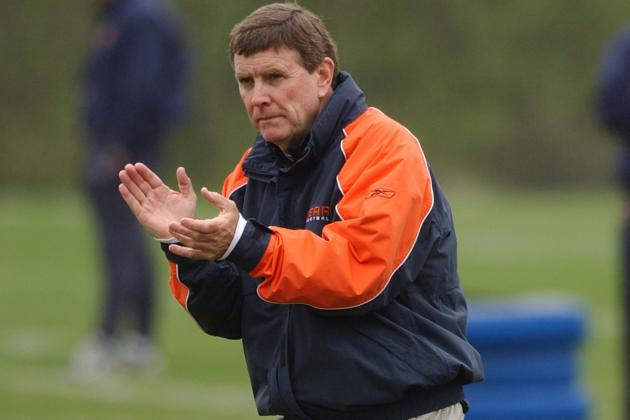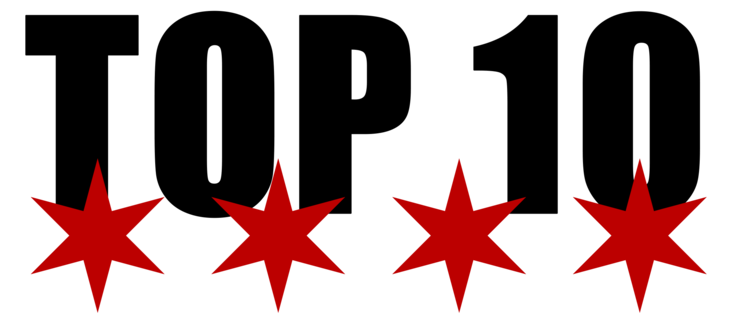Study In Contrasts


Few coaching positions on the Chicago Bears have a more illustrious history than defensive coordinator. It’s practically a who’s who of names and personalities from the great George Allen to the flamboyant Buddy Ryan to the fondly remembered “Riverboat” Ron Rivera. All had great runs of success overseeing arguably the greatest defenses in franchise history and took or have taken them to great runs as head coaches in the NFL.
Conversely, the Bears offensive coordinator position has become one of the bigger running jokes in football. Try as they might the team has continued to fumble that position dating back decades. Aside from one or two bright spots, it looks about as ugly as it can get.
Sid Gillman (1977)


Subscribe to the BFR Youtube channel and ride shotgun with Dave and Ficky as they break down Bears football like nobody else.
Many consider him the father of the modern NFL offense. Sid Gillman revolutionized the passing game in pro football. Several of his schemes and teaching methods are still in use today. He had an incredible run of coaching that spanned over four decades. Unfortunately the Bears got him too late.
Gillman was 65 when he signed on as offensive coordinator in 1977. It would be his final season before retirement, but not before coaxing the best performance out of a Chicago offense in years. They finished 3rd in total yards for the season and running back Walter Payton had the best year of his Hall of Fame career, compiling over 2, 100 yards from scrimmage and scoring 16 touchdowns.
The Bears made the playoffs for the first time since 1963.
Ken Meyer (1978-1980)


*Furthest on the right
It became apparent right away that Ken Meyer had no magic potions to offer the Bears. His first year in charge, his quarterbacks threw an astounding 28 interceptions to just seven touchdowns. It wasn’t much better in 1979 as they finished lower in ranking than the year before but made the playoffs thanks to Payton and a stout defense.
No Meyer offense finished above 22nd.
Ted Marchibroda (1981)


One of several one-year experiments the Bears would have in their long history. Ted Marchibroda brought plenty of experience with him to the job, having been offensive coordinator for the Redskins when they reached the Super Bowl in 1972 and then reviving the Baltimore Colts in the late ‘70s as head coach.
As it turns out though he was little more than the last ditch hope of a desperate head coach in Neill Armstrong trying to find answers on offense. Answers Marchibroda had no time to provide. His unit finished 26th in the league, scoring in single digits five times. His quarterbacks ended up completing just 45.4% of their passes.
Ed Hughes (1982-1988)


If there is one thing Ed Hughes deserves credit for, it’s stability. He was by far the longest-tenured offensive coordinator of the Super Bowl era in Chicago. He oversaw the Bears’ dominance during the 1980s, helping them forge one of the best rushing attacks in NFL history that culminated in a championship in 1985.
Between 1983 and 1986 his offenses finished in the top 7 in yards and had two years of top 10 placements in points scored. However, like many other coordinators on this list he was undone by constant turmoil at the quarterback position. The inability of Jim McMahon to stay healthy or find a replacement for him eventually resulted in Hughes leaving after seven seasons.
Greg Landry (1988-1992)


It turns out Bears offensive coordinator was the only prominent coaching position Greg Landry would ever hold in the NFL. The former quarterback of the Detroit Lions did a fairly admirable job replacing Hughes. His offenses never finished lower than 13th in yards and finished in the top 10 twice in points scored while keeping the tradition of great running games going into the 1990s.
The Bears won two division titles under his watch but failed to equal the success of his predecessor.
Ron Turner (1993-1996)


The first foray the franchise made into the Ron Turner water was largely forgetful. Three of the four years he was in command of the offense results into finishes 21st or worse in yards and 24th or worse in points scored. Only in 1995, led by quarterback Erik Kramer and a pair of speed receivers in Jeff Graham and Curtis Conway did Chicago light up the scoreboard. Kramer threw for a franchise single-season record 3, 823 yards and 29 touchdowns while Graham posted 1, 301 yards receiving and Conway scored 12 touchdowns.
The Bears finished 9th overall in offense that year. Predictably, things regressed the next season and Turner was fired.
Matt Cavanaugh (1997-1998)


A rising star in the late 90s, former quarterback turned coach Matt Cavanaugh had found quick success in Arizona and San Francisco by the time the Bears decided to make him their OC. He had no prior experience calling plays and it became obvious pretty fast that he was not up to the task required to lift that unit out of the quagmire.
Plagued by problems across the roster, both in terms of limited talent but also injuries, the team continued to struggle. Though they could move the ball at times, scoring was the big issue as they finished 28th and 25th during his two seasons.
Gary Crowton (1999-2000)


People may not remember this, but Chicago was actually one of the first teams in the NFL to experiment with bringing the highly successful college spread offense into pros. Gary Crowton was one of the guys who made it famous at Louisiana Tech, so he was lured to the Bears in hopes he had some answers for their problems.
At first things looked promising. In 1999, despite starting three different quarterbacks, Chicago finished 8th in the NFL in yards and 3rd in passing. Expectations were high entering 2000 that the team could compete given the quality additions they made in the draft on defense with guys like Brian Urlacher and Mike Brown.
It didn’t pan out. Crowton became the latest victim unable to solve the quarterback problem. Defenses also began to catch on to what he was doing, noting that the Bears rarely threw balls deep. He never attacked directly through the air or on the ground and once the NFL realized that, he was finished.
John Shoop (2001-2003)


Careful mentioning this name around Chicago. It may get you beaten up. John Shoop has one of the most villainous reputations in team history. No, not because he’s a terrible person or anything but because the guy seemed to have little to no understanding of offensive football. If anything, he was to prove more conservative and some might say cowardly than Crowton.
“Shoop’s inherent cowardice became apparent in 2001, when the team ranked 26th in the NFL in total yards and managed just 192 yards per game through the air. The great defense and good fortune (+13 in turnovers) of that team led to a 13-3 season and hid Shoop’s deficiencies to an extent, but the grumbles were already beginning before a 4-12 2002 campaign brought them to a fever pitch. Shoop’s 2002 offense finished 27th in the NFL in points, 29th in yardage, and managed just 190 yards through the air. By this point it had become apparent that Shoop’s entire offense consisted largely of unimaginative runs up the middle by the slow-footed Anthony Thomas, the long-since obsolete bubble screen (the only holdover that Shoop had kept from Crowton’s attack) and an absolute refusal to consider a downfield attack. Quarterbacks during the Shoop Era averaged a whopping 5.7 yards per attempt.”
It seemed like every time the Bears need seven or eight yards for a first down, Shoop would call a five yard pass play. Inevitably they’d almost always be stopped before the marker and the team would have to punt. Maybe the lack of talent had something do to with it, but his utter lack of imagination was a far bigger issue.
Terry Shea (2004)


The first of Lovie Smith’s many forays into the offensive coordinator quest that ultimately became his search for the Holy Grail. Terry Shea was undone almost from the beginning. The loss of quarterback Rex Grossman to a season-ending injury forced him to rely on others like Jonathan Quinn, Craig Krenzel and Chad Hutchinson which may have been the low point in Bears history for play at that position.
Shea did little to help himself though. Like so many before him, he lacked imagination to adjust to his units’ strengths while hiding the weaknesses. His quarterbacks were sacked 66 times that season and the offense finished dead last in the league in both yards and points.
Ron Turner 2.0 (2005-2009)


Everybody knows what is said about sequels. They’re rarely as good as the original. In this case it was largely true. To his credit, Ron Turner at least improved things from where they were during the Dark Ages of Crowton, Shoop and Shea. Chicago got back to running the football effectively with backs like Thomas Jones. He also coaxed 10 wins out of rookie quarterback Kyle Orton in 2005.
Then in 2006 things took off. The Bears finished 2nd in points, scoring 30 or more eight times on their way to the first Super Bowl berth in 21 years. Sadly his unit didn’t perform when it mattered most. They managed just 10 points in the big game (the other 7 came from Devin Hester’s opening kickoff) and they managed 154 yards passing.
Again, like back in the ‘90s, Turner’s unit began to regress after an early rise and by 2009 he was out for the final time.
Mike Martz (2010-2011)


Arguably the most hotly debated coordinator in a long time. Was Mike Martz as bad as some say or was he wrongly fired right before things were set to take off? The wizard who built the Greatest Show on Turf in St. Louis arrived with a somewhat cooled reputation in 2010 after failed stints in Detroit and San Francisco. His job became simple: turn quarterback Jay Cutler back into the Pro Bowler he was in Denver.
Yet Martz did not have the receiver or offensive line the Broncos did. Coupled with his stubbornness for wanting to throw the football, it resulted in some ugly returns in the early going. However, he soon began to adjust. Chicago ran the football more and things clicked late in the season. The offense scored 30 or more points in four of seven games prior to their berth in the NFC championship.
A year later expectations were even higher and for a brief moment it looked like they were validated. After another slow start, the Martz-Cutler union peaked between mid-October and mid-Novemeber of 2011 when the Bears rattled off five-straight wins while scoring 30 or more points in four of those games.
Then things imploded. Cutler broken the thumb on his throwing hand, knocking him out the rest of the regular season. With no discernible talent behind him at backup, Martz couldn’t get his offense to execute. It would score more than 20 points just once the rest of the season. That failure, fair or not, was placed on his shoulders and Lovie Smith fired him shortly afterward.
Mike Tice (2012)


As a former head coach it really didn’t seem like that big of a stretch for the Bears to promote offensive line coach Mike Tice to the job in 2012. He would embrace the idea of running the football and take some of the heat off Cutler. He at least fulfilled that promise as the Bears ran the ball 470 times. However, that didn’t cover up his lack of play calling experience or creativity.
The offense essentially degenerated into handing the ball to Matt Forte and letting Cutler and newly-acquired receiver Brandon Marshall play catch. Marshall caught 118 passes that season. The next closest was Earl Bennett with 29. The team started off well but like Martz, an injury to Cutler midway through the season exposed how overmatched Tice was.
By the time Jay was back the momentum had been lost. Chicago went through a swoon of scoring 17 or fewer points in five out of six games. They finished 10-6, missed the playoffs and the entire coaching staff was fired.
Aaron Kromer (2013-2014)


He may have held the title of offensive coordinator but in truth Aaron Kromer was more of an organizer since head coach Marc Trestman was the one calling the plays. It would be wrong to ignore his impact, at least early on. The offensive line, his specialty, was one of the best in the NFL in 2013 and helped pave the way to the first top 10 finish for a Bears offense in over a decade.
That said Kromer also had a reputation for not keeping his mouth shut. It became clear in 2014 when the unit was struggling and he chose to call out Jay Cutler for his inefficient play to an NFL insider. Inevitably it got out to the media and soon he was exposed for having broken a cardinal locker room rule.
A divide soon formed between the players and coaches and the Bears collapsed to a 5-11 finish. The staff was fired and Kromer went to Buffalo where he was almost fittingly arrested for assaulting somebody on a local beach.
Adam Gase (2015-?)
Maybe there really is a light at the end of the tunnel. Halfway through the 2015 season and it’s apparent that if anything else the Chicago Bears have hired somebody as offensive coordinator who is at least competent in Adam Gase. He’s young but experienced and shown plenty of creativity as a play caller. Best of all, he has a strong connection with Jay Cutler that is producing some of the most efficient football the quarterback has ever played.
So now the concerns shift away from how bad the coach is to how long he might stay. Gase is expected to be one of the hottest head coaching candidates in 2016. Could the Bears lose maybe the best they’ve had in decades after just one season?
That would be their kind of luck.












